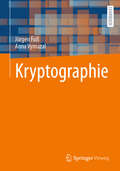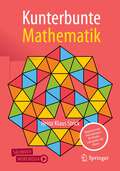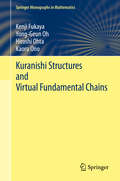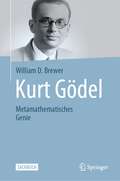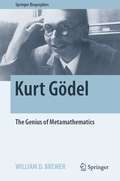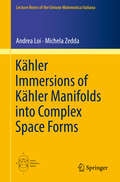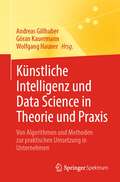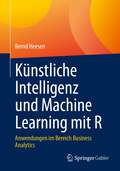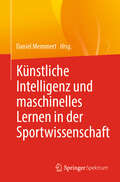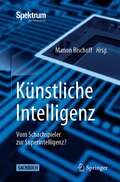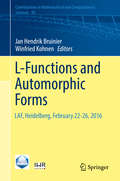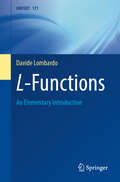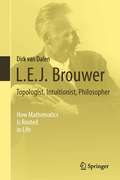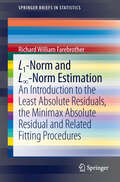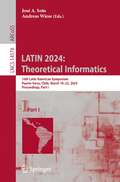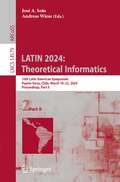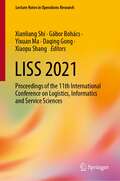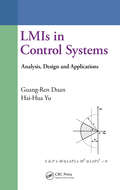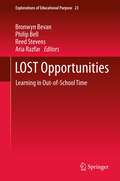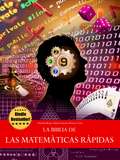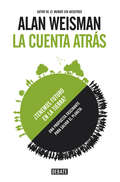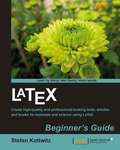- Table View
- List View
Kryptographie
by Jürgen Fuß Anna VymazalDieses Lehrbuch präsentiert umfassend die Grundlagen der Kryptographie, beginnend mit symmetrischen Verfahren zur Sicherung von Vertraulichkeit, Integrität und Authentizität bis hin zu aktuellen Public-Key-Verfahren und Post-Quantum-Kryptographie. Im ersten Teil werden die notwendigen Eigenschaften für sichere Kommunikation erläutert, wobei klare Sicherheitsdefinitionen komplexe Anforderungen vereinfachen. Kommunikationssysteme und Angriffsszenarien werden anhand von „Spielen“ veranschaulicht, die die Basis für formale Sicherheitsbeweise bilden. Der Fokus des zweiten Teils liegt auf Sicherheit und Performance, insbesondere bei der Schlüsselerzeugung und der Optimierung von Public-Key-Verfahren. Auch Aspekte der Post-Quantum-Kryptographie werden behandelt. Das Buch vereint Kryptographie und Mathematik und ist daher auch für Leserinnen und Leser ohne hochschulische mathematische Vorbildung geeignet.
Kunterbunte Mathematik: Begeisternde Erkundungen für Kinder, Lehrende und Eltern
by Heinz Klaus StrickDieses Buch zeichnet ein – im wahrsten Sinne des Wortes – farbenfrohes Bild von Mathematik: Es stellt eine Auswahl von mathematischen Themen vor, die mithilfe durchgehend farbig gestalteter Abbildungen und unterstützt durch möglichst einfache Erläuterungen erschlossen werden. Auf Formeln und Rechnungen wurde soweit wie möglich verzichtet.Das Buch eignet sich insbesondere für Kinder ab etwa 8 Jahren und Jugendliche. Lehrenden und Eltern bietet es entsprechende Anregungen für gemeinsame mathematische Erkundungen. Die einzelnen Kapitel sind im Wesentlichen unabhängig voneinander lesbar, sodass sie möglichst vielseitig einsetzbar sind. Durch regelmäßig eingestreute Anregungen zum Nachdenken und Anstöße für eigene Untersuchungen wird mathematisches Entdecken erlebbar. Lösungshinweise zu diesen Anregungen sowie Kopiervorlagen werden online zur Verfügung gestellt.Die Mehrzahl der Themen wird Leserinnen und Lesern der beliebten Bücher Mathematik ist schön, Mathematik ist wunderschön und Mathematik ist wunderwunderschön bekannt vorkommen – es handelt sich um eine Auswahl von Inhalten aus diesen Büchern, die hier größtenteils völlig neu aufbereitet wurden: Die Darstellungen sind im vorliegenden „kunterbunten“ Buch nochmal sehr viel anschaulicher, ausführlicher und kindgerechter. Außerdem sind weitere Themen hinzugekommen, die sich besonders für jüngere Mathematikinteressierte eignen.
Kuranishi Structures and Virtual Fundamental Chains (Springer Monographs in Mathematics)
by Yong-Geun Oh Kenji Fukaya Hiroshi Ohta Kaoru OnoThe package of Gromov’s pseudo-holomorphic curves is a major tool in global symplectic geometry and its applications, including mirror symmetry and Hamiltonian dynamics. The Kuranishi structure was introduced by two of the authors of the present volume in the mid-1990s to apply this machinery on general symplectic manifolds without assuming any specific restrictions. It was further amplified by this book’s authors in their monograph Lagrangian Intersection Floer Theory and in many other publications of theirs and others. Answering popular demand, the authors now present the current book, in which they provide a detailed, self-contained explanation of the theory of Kuranishi structures.Part I discusses the theory on a single space equipped with Kuranishi structure, called a K-space, and its relevant basic package. First, the definition of a K-space and maps to the standard manifold are provided. Definitions are given for fiber products, differential forms, partitions of unity, and the notion of CF-perturbations on the K-space. Then, using CF-perturbations, the authors define the integration on K-space and the push-forward of differential forms, and generalize Stokes' formula and Fubini's theorem in this framework. Also, “virtual fundamental class” is defined, and its cobordism invariance is proved.Part II discusses the (compatible) system of K-spaces and the process of going from “geometry” to “homological algebra”. Thorough explanations of the extension of given perturbations on the boundary to the interior are presented. Also explained is the process of taking the “homotopy limit” needed to handle a system of infinitely many moduli spaces. Having in mind the future application of these chain level constructions beyond those already known, an axiomatic approach is taken by listing the properties of the system of the relevant moduli spaces and then a self-contained account of the construction of the associated algebraic structures is given. This axiomatic approach makes the exposition contained here independent of previously published construction of relevant structures.
Kurt Gödel and the Foundations of Mathematics
by Christos H. Papadimitriou Matthias Baaz Hilary W. Putnam Dana S. Scott Charles L. HarperThis volume commemorates the life, work, and foundational views of Kurt Gödel (1906-1978), most famous for his hallmark works on the completeness of first-order logic, the incompleteness of number theory, and the consistency - with the other widely accepted axioms of set theory - of the axiom of choice and of the generalized continuum hypothesis. It explores current research, advances, and ideas for future directions not only in the foundations of mathematics and logic, but also in the fields of computer science, artificial intelligence, physics, cosmology, philosophy, theology, and the history of science. The discussion is supplemented by personal reflections from several scholars who knew Gödel personally, providing some interesting insights into his life. By putting his ideas and life's work into the context of current thinking and perceptions, this book will extend the impact of Gödel's fundamental work in mathematics, logic, philosophy, and other disciplines for future generations of researchers.
Kurt Gödel: Metamathematisches Genie
by William D. BrewerZu seinen Lebzeiten war Kurt Gödel außerhalb der Fachwelt der Mathematiker, Philosophen und theoretischen Physiker kaum bekannt. Zu Beginn seiner Karriere schuf er beeindruckende Arbeiten zur Vollständigkeit und Beweisbarkeit formaler logischer Systeme, die zu seiner Dissertation und seiner Habilitations-schrift wurden und ihn unter Fachleuten weltberühmt machten. Seine Unvoll-ständigkeitssätze läuteten das Ende der formal-logischen Programme der Logizisten (Russell et al.) und der Formalisten (Hilbert et al.) ein. Später erzielte er auch signifikante Ergebnisse in der Mengenlehre. Nach seiner Emigration in die USA (Princeton), widmete er sich mehr der Philosophie, dem Leitmotiv seines Lebens, und er fand auch eine einzigartige Lösung zu Einsteins Feld-gleichungen der Gravitation, sein “Gödel-Universum“. Dieses Buch beschreibt sowohl den Gödel, der ein genialer Wissenschaftler war, und der gewagte und neuartige Hypothesen zu den Fundamenten der Mathe-matik und Physik hervorbrachte, ‒ als auch den Gödel, der ein perfekter Rationalist war, aber sein Alltagsleben nur mit Mühe meistern konnte und zeitlebens unter Depressionen, Angstneurosen und Hypochondrie litt. Ein Leben voller Paradoxen, in dem er trotz all seiner psychischen Probleme Beachtliches leistete und zu einem Vorbild für viele jüngere Wissenschaftler wurde. Das Buch liefert den Kontext zu seinen Errungenschaften, die ein verblüffend breites Spektrum intellektueller Unternehmungen darstellen, und zu seiner zunehmenden Geisteskrankheit; und es zeigt, wie er eine lange und erfolgreiche Karriere mit Hilfe seiner loyalen Ehefrau Adele und einigen seiner Freunde durchlaufen konnte. Dies ist eine faszinierende Geschichte der wissen-schaftlichen Genialität und der menschlichen Natur.
Kurt Gödel: The Genius of Metamathematics (Springer Biographies)
by William D. BrewerDuring his lifetime, Kurt Gödel was not well known outside the professional world of mathematicians, philosophers and theoretical physicists. Early in his career, for his doctoral thesis and then for his Habilitation (Dr.Sci.), he wrote earthshaking articles on the completeness and provability of mathematical-logical systems, upsetting the hypotheses of the most famous mathematicians/philosophers of the time. He later delved into theoretical physics, finding a unique solution to Einstein’s equations for gravity, the ‘Gödel Universe’, and made contributions to philosophy, the guiding theme of his life. This book includes more details about the context of Gödel’s life than are found in earlier biographies, while avoiding an elaborate treatment of his mathematical/scientific/philosophical works, which have been described in great detail in other books. In this way, it makes him and his times more accessible to general readers, and will allow them to appreciate the lasting effects of Gödel’s contributions (the latter in a more up-to-date context than in previous biographies, many of which were written 15–25 years ago). His work spans or is relevant to a wide spectrum of intellectual endeavor, and this is emphasized in the book, with recent examples. This biography also examines possible sources of his unusual personality, which combined mathematical genius with an almost childlike naiveté concerning everyday life, and striking scientific innovations with timidity and hesitancy in practical matters. How he nevertheless had a long and successful career, inspiring many younger scholars along the way, with the help of his loyal wife Adele and some of his friends, is a fascinating story in human nature.
Kähler Immersions of Kähler Manifolds into Complex Space Forms (Lecture Notes of the Unione Matematica Italiana #23)
by Andrea Loi Michela ZeddaThe aim of this book is to describe Calabi's original work on Kähler immersions of Kähler manifolds into complex space forms, to provide a detailed account of what is known today on the subject and to point out some open problems. Calabi's pioneering work, making use of the powerful tool of the diastasis function, allowed him to obtain necessary and sufficient conditions for a neighbourhood of a point to be locally Kähler immersed into a finite or infinite-dimensional complex space form. This led to a classification of (finite-dimensional) complex space forms admitting a Kähler immersion into another, and to decades of further research on the subject. Each chapter begins with a brief summary of the topics to be discussed and ends with a list of exercises designed to test the reader's understanding. Apart from the section on Kähler immersions of homogeneous bounded domains into the infinite complex projective space, which could be skipped without compromising the understanding of the rest of the book, the prerequisites to read this book are a basic knowledge of complex and Kähler geometry.
Künstliche Intelligenz und Data Science in Theorie und Praxis: Von Algorithmen und Methoden zur praktischen Umsetzung in Unternehmen
by Göran Kauermann Andreas Gillhuber Wolfgang HaunerDieser Sammelband verbindet theoretische Grundlagen und praktische Anwendungen von Künstlicher Intelligenz (KI) und Data Science: Anerkannte Experten stellen in ihren Beiträgen den aktuellen Stand in Forschung und Wirtschaft dar – und bieten so einen einzigartigen Überblick über aktuelle Konzepte und ihre Umsetzung in Unternehmen. Im ersten Teil des Buchs werden die Methoden und Algorithmen skizziert, die sich größtenteils aus einer Kombination von Statistik und Informatik ergeben und auf Verfahren des Maschinellen Lernens bis hin zu Deep Learning und KI basieren. Im zweiten Teil wird die konzeptionelle Umsetzung in der Praxis skizziert: Hier wird insbesondere aufgezeigt, welche Herausforderungen in der Praxis auftreten – ob nun bei der Einbettung der Daten-Use-Cases in eine Gesamtstrategie oder bei der Produktivsetzung, Weiterentwicklung und dem Betrieb von Daten-basierten Lösungen. Der dritte Teil zeigt das breite Potpourri von Data Science in der Praxis: Branchengrößen wie Allianz, ADAC, BMW, Deutsche Bahn, Lufthansa, REWE, RTL, St. Galler Stadtwerke, SwissRe und viele weitere zeigen konkret, welche Erfahrungen sie bei ihren Projekten gesammelt haben. Fachartikel von über 20 namhaften Unternehmen decken die spezifischen Anforderungen ihrer jeweiligen Branchen ab. Das Buch möchte die interdisziplinäre Diskussion und Kooperation zwischen Wissenschaft und Wirtschaft fördern und richtet sich daher an verschiedene Lesergruppen:Studierende und Absolventen, die Orientierung für die eigene Laufbahn suchen.Forschende und Lehrende, die einen Einblick in praxisrelevante Einsatzgebiete erhalten möchten.Anwender, Praktiker und Entscheider, die sich über Chancen und Herausforderungen von KI in der Praxis informieren möchten.
Künstliche Intelligenz und Machine Learning mit R: Anwendungen im Bereich Business Analytics
by Bernd HeesenIn einer VUCA-Welt, die sich als immer unbeständiger, unsicherer und komplexer erweist, gilt es für Unternehmen, Organisation und Staaten zeitnah und adäquat auf die jeweiligen Situationen zu reagieren. Entscheidungen basierend auf in der Vergangenheit gemachten Erfahrungen zu treffen ist in diesen Zeiten weniger erfolgreich als ein akkurates Verständnis der gegenwärtigen Bedingungen. Die Bedeutung von empirischen Wissenschaften, das permanente Beobachten der Umwelt, die zeitnahe Analyse von Wirkungszusammenhängen und das daraus abgeleitete Gewinnen neuer Erkenntnissen, nimmt zu. Daraus lässt sich ableiten, welche Maßnahmen mit einer vorhersagbaren Wahrscheinlichkeit zur Erreichung der eigenen Ziele geeignet sind, z.B. welcher Preis für ein Angebot die gewünschte Nachfrage erzeugt oder welche Marketingmaßnahme eine gewünschte Zielgruppe erreicht.Wo früher klassische Statistik für Berechnungen und Vorhersagen herangezogen wurde, da erlauben heute kostenlose (Open Source) Werkzeuge wie R Daten in unterschiedlichsten Formaten und aus beliebig vielen Quellen für die Analyse einzulesen, aufzubereiten und mit Hilfe von Methoden der Künstlichen Intelligenz und des Machine Learning zu analysieren. Die Ergebnisse können dann anschließend perfekt visuell dargestellt werden, so dass die Entscheider schnell und effektiv davon profitieren können.Das Zeitalter von Data Science ist erreicht. Digitalisierung ist mehr als ein Schlagwort oder ein Versprechen, es ist für jeden umsetzbar und nutzbar.Dieses Buch vermittelt Ihnen auf Basis der zum Zeitpunkt der Publikation aktuellsten Version von R, wie Sie Künstliche Intelligenz und Machine Learning in der Industrie 4.0 nutzen können.
Künstliche Intelligenz und maschinelles Lernen in der Sportwissenschaft
by Daniel MemmertDieses Fachbuch zeigt als eine der ersten deutschsprachigen Buchpublikationen in einer umfassenden Übersicht, wie künstliche Intelligenz (KI) und maschinelles Lernen (ML) im Kontext der sportwissenschaftlichen Forschung und Praxis zum Einsatz kommen. Neben den Grundlagen der KI und des ML werden verschiedene Anwendungen beschrieben, darunter selbstlernende Algorithmen zur Analyse von Bewegungsmustern von Athleten und intelligente Wearables, die Echtzeitdaten liefern. Durch die Integration von Big Data können Spielergebnisse, Fitnessparameter und individuelle Leistungen eingehend analysiert werden, was zu neuen Entwicklungen in der Forschung führt. Von der Leistungsanalyse bis hin zur Verletzungsprävention und personalisierten Trainingsmethoden bieten sich vielfältige Möglichkeiten für zukünftige Forschung und Praxis. Mehr als 25 Expertinnen und Experten tragen dazu bei, das große Themenspektrum von KI und ML abzubilden und den neuesten Forschungsstand prägnant zusammenzufassen. Hierbei werden in übergeordneten Buchsektionen verschiedene Themenkomplexe geclustert, darunter allgemeine Grundlagen, Metriken im Mannschaftssport, Metriken in Individualsportarten und Anwendungen in der Sportwissenschaft. In einem Ausblick werden zudem ethische Fragestellungen im Zusammenhang mit dem Einsatz von KI und ML im Sport sowie deren verantwortungsbewusste Anwendung behandelt. Insgesamt erhalten Fachkräfte und Forschende mit Bezug zur Sportinformatik, Sporttechnologie, Trainingswissenschaft und Sportmedizin ein umfassendes Nachschlagewerk mit praxisnahen Beispielen zu einem innovativen Forschungsgebiet.
Künstliche Intelligenz: Vom Schachspieler zur Superintelligenz?
by Manon BischoffKünstliche Intelligenz ist längst nicht mehr nur ein ernstzunehmender Schachgegner, sondern reicht in der Anwendung weit in unseren Alltag hinein. Doch was macht einen Computer eigentlich intelligent? Wie lernen Algorithmen und wie bringt man einer Maschine das Spielen bei? Wobei kann uns KI heute und in Zukunft helfen – und wo versagen die selbstlernenden Programme?Die hier zusammengestellten Artikel aus »Spektrum der Wissenschaft«, »Gehirn&Geist« und »spektrum.de« bieten eine themenübergreifende Übersicht zu den wichtigsten Fragen der künstlichen Intelligenz. Interessierte Laien ohne besonderes Vorwissen erhalten einen Überblick von den Grundlagen neuronaler Netze und evolutionärer Algorithmen bis hin zu aktuellen Forschungsfragen aus Naturwissenschaft und Technik.Im ersten Teil des Buchs erfahren Sie, wie man einem Computer beibringt, selbstständig zu lernen, mit welchen Tricks man Algorithmen weiter verbessert und bekannte Schwächen behebt – und wie sogar Maschinen kreativ werden können. Inwiefern das speziell beim Erlernen von Brett- und Videospielen passiert und was das für weitere Anwendungen bedeutet, erklären wir im zweiten Teil. Der dritte Abschnitt beschäftigt sich mit den Fortschritten in Forschung und Technik, die Wissenschaftler mit Hilfe von KI erlangen: von der Suche nach neuer Physik bis hin zu der Entwicklung neuer Medikamente. Das letzte Kapitel widmet sich der Frage, wo die Grenzen des vermeintlichen Alleskönners KI liegen – und welche potenziellen Gefahren heute und in Zukunft davon ausgehen.
L-Functions and Automorphic Forms (Contributions In Mathematical And Computational Sciences Ser. #10)
by Winfried Kohnen Jan Hendrik BruinierThis book presents a collection of carefully refereed research articles and lecture notes stemming from the Conference "Automorphic Forms and L-Functions", held at the University of Heidelberg in 2016. The theory of automorphic forms and their associated L-functions is one of the central research areas in modern number theory, linking number theory, arithmetic geometry, representation theory, and complex analysis in many profound ways. The 19 papers cover a wide range of topics within the scope of the conference, including automorphic L-functions and their special values, p-adic modular forms, Eisenstein series, Borcherds products, automorphic periods, and many more.
L-Functions: An Elementary Introduction (UNITEXT #171)
by Davide LombardoThis book provides an accessible introduction to the theory of L-functions, emphasising their central role in number theory and their direct applications to key results. Designed to be elementary, it offers readers a clear pathway into the subject, starting from minimal background. It describes several important classes of L-functions — Riemann and Dedekind zeta functions, Dirichlet L-functions, and Hecke L-functions (for characters with finite image) — by showing how they are all special cases of the construction, due to Artin, of the L-function of a Galois representation. The analytic properties of abelian L-functions are presented in detail, including the full content of Tate's thesis, which establishes analytic continuation and functional equations via harmonic analysis. General Hecke L-functions are also discussed, using the modern perspective of idèles and adèles to connect their analytic theory with the representation-theoretic approach of Artin's L-functions. A distinguishing feature of this book is its accessibility: while largely avoiding arithmetic geometry, it provides introductions to both algebraic number theory and key aspects of representation theory. This approach ensures that the material is accessible to both beginning graduate students and advanced undergraduates. Applications play a central role throughout, highlighting how L-functions underpin significant results in number theory. The book provides complete proofs of the prime number theorem, Dirichlet's theorem on primes in arithmetic progressions, Chebotarev's density theorem, and the analytic class number formula, demonstrating the power of the theory in solving classical problems. It serves as an ideal introduction for advanced undergraduates and beginning graduate students and can also be a useful reference for preparing a course on the subject.
L.E.J. Brouwer – Topologist, Intuitionist, Philosopher
by Dirk Van DalenDirk van Dalen's biography studies the fascinating life of the famous Dutch mathematician and philosopher Luitzen Egbertus Jan Brouwer. Brouwer belonged to a special class of genius; complex and often controversial and gifted with a deep intuition, he had an unparalleled access to the secrets and intricacies of mathematics. Most mathematicians remember L.E.J. Brouwer from his scientific breakthroughs in the young subject of topology and for the famous Brouwer fixed point theorem. Brouwer's main interest, however, was in the foundation of mathematics which led him to introduce, and then consolidate, constructive methods under the name 'intuitionism'. This made him one of the main protagonists in the 'foundation crisis' of mathematics. As a confirmed internationalist, he also got entangled in the interbellum struggle for the ending of the boycott of German and Austrian scientists. This time during the twentieth century was turbulent; nationalist resentment and friction between formalism and intuitionism led to the Mathematische Annalen conflict ('The war of the frogs and the mice'). It was here that Brouwer played a pivotal role. The present biography is an updated revision of the earlier two volume biography in one single book. It appeals to mathematicians and anybody interested in the history of mathematics in the first half of the twentieth century.
L1-Norm and L∞-Norm Estimation
by Richard William FarebrotherThis monograph is concerned with the fitting of linear relationships in the context of the linear statistical model. As alternatives to the familiar least squared residuals procedure, it investigates the relationships between the least absolute residuals, the minimax absolute residual and the least median of squared residuals procedures. It is intended for graduate students and research workers in statistics with some command of matrix analysis and linear programming techniques.
LATIN 2024: 16th Latin American Symposium, Puerto Varas, Chile, March 18–22, 2024, Proceedings, Part I (Lecture Notes in Computer Science #14578)
by Andreas Wiese José A. SotoThis book constitutes the proceedings of the 16th Latin American Symposium on Theoretical Informatics, LATIN 2042, which took place in Puerto Varas, Chile, in March 2024. The 44 papers presented in this volume were carefully reviewed and selected from 93 submissions. They were organized in topical sections as follows:Part I: Algorithms and Data Structures; Approximation and Online Algorithms; Complexity Theory; Part II: Combinatorics and Graph Theory; Parameterized Algorithms; Automata Theory and Formal Languages; and Game Theory and Fairness.
LATIN 2024: 16th Latin American Symposium, Puerto Varas, Chile, March 18–22, 2024, Proceedings, Part II (Lecture Notes in Computer Science #14579)
by Andreas Wiese José A. SotoThis book constitutes the proceedings of the 16th Latin American Symposium on Theoretical Informatics, LATIN 2042, which took place in Puerto Varas, Chile, in March 2024. The 44 papers presented in this volume were carefully reviewed and selected from 93 submissions. They were organized in topical sections as follows:Part I: Algorithms and Data Structures; Approximation and Online Algorithms; Complexity Theory; Part II: Combinatorics and Graph Theory; Parameterized Algorithms; Automata Theory and Formal Languages; and Game Theory and Fairness.
LISS 2021: Proceedings of the 11th International Conference on Logistics, Informatics and Service Sciences (Lecture Notes in Operations Research)
by Xianliang Shi Xiaopu Shang Gábor Bohács Daqing Gong Yixuan MaThis book aims to provide new research methods, theories and applications from various areas of management and engineering. In detail, the included scientific papers analyze and describe communication processes in the fields of logistics, informatics, service sciences and other related areas. The variety of the papers delivers added value for both scholars and practitioners. Information and communication technologies have been providing an effective network infrastructure and development platform for logistics and service operations. To meet the needs of consumers and to promote core competences, many institutions and firms have been developing new types of services. This proceeding focus on “AI and data driven technical and management innovation in logistics, informatics and services.” In detail, the included scientific papers analyze the latest fundamental advances in the state of the art and practice of logistics, informatics, service operations and service science. This book is the documentation of the conference “11th International Conference on Logistics, Informatics and Service Sciences,” which took place at the Shandong University. Due to the impact of COVID-19, LISS 2021 took place online as a virtual conference.
LMIs in Control Systems: Analysis, Design and Applications
by Guang-Ren Duan Hai-Hua YuAlthough LMI has emerged as a powerful tool with applications across the major domains of systems and control, there has been a need for a textbook that provides an accessible introduction to LMIs in control systems analysis and design. Filling this need, LMIs in Control Systems: Analysis, Design and Applications focuses on the basic analysis and d
LOST Opportunities
by Reed Stevens Philip Bell Aria Razfar Bronwyn BevanLearning in informal settings is attracting growing attention from policymakers and researchers, yet there remains, at the moment, a dearth of literature on the topic. Thus this volume, which examines how science and mathematics are experienced in everyday and out-of-school-time (OST) settings, makes an important contribution to the field of the learning sciences. Conducting research on OST learning requires us to broaden and deepen our conceptions of learning as well as to better identify the unique and common qualities of different learning settings. We must also find better ways to analyze the interplay between OST and school-based learning. In this volume, scholars develop theoretical structures that are useful not only for understanding learning processes, but also for helping to create and support new opportunities for learning, whether they are in or out of school, or bridging a range of settings. The chapters in this volume include studies of everyday and 'situated' processes that facilitate science and mathematics learning. They also feature new theoretical and empirical frameworks for studying learning pathways that span both in- and out-of-school time and settings. Contributors also examine structured OST programs in which everyday and situated modes of learning are leveraged in support of more disciplined practices and conceptions of science and mathematics. Fortifying much of this work is a leading focus on educational equity--a desire to foster more socially supportive and intellectually engaging science and mathematics learning opportunities for youth from historically non-dominant communities. Full of compelling examples and revealing analysis, this book is a vital addition to the literature on a subject with a fast-rising profile.
La Biblia de las Matemáticas Rápidas
by Danilo Lapegna Manuel Antonio Monroy Correa Yamada Takumi¿Qué tal un libro que te explique cómo las matemáticas pueden darte interminables herramientas estratégicas para permitirte ahorrar más dinero, hacer mejor y mejor tu trabajo, mejorar tus estudios, regresar a estar en forma y estar siempre en tu mejor momento? ¿Qué tal un libro que te pueda mostrar cómo hacer que el destino esté de tu lado en juegos de apuesta como el Póquer y el Veintiuno, con tan sólo un par de sumas mentales? ¿Qué tal un libro que pueda enseñarte fácilmente cómo sumar, dividir, multiplicar aún entre números de 5 cifras en 10 segundos? Bueno, ¿qué tal echándole un vistazo a "La Biblia de las Matemáticas Rápidas"? Directamente de las investigaciones de años de dos ingenieros de software, un libro revolucionario que te enseñará las matemáticas desde un puntno de vista completamente nuevo. Rápidamente aprenderás a cómo realizar cálclos extremadamente complejos en unos cuantos segundos; adquirirás valiosas competencias clave para el mundo académico y de negocios y, verás cómo muchas preciadas herramientas de estrategia para la vida diaria pueden construirse simplemente con las matemáticas que aprendiste en la escuela. ¡Teoría del juego, teoría de la probabilidad, matemáticas védicas, estrategias de guerra, culturas antiguas y estudios modernos se entretejen en un volumen que difícilmente olvidarás y siempre querrás conservar en tu biblioteca!
La cuenta atrás: ¿Tenemos futuro en la tierra?
by Alan WeismanUna propuesta fascinante para salvar el planeta. La cuenta atrás es un libro audaz, inteligente y provocador, que nos explica cuáles son los efectos de nuestro desmesurado crecimiento demográfico y plantea la alternativa más rápida y razonable para restaurar el equilibrio. Una investigación de conclusiones revolucionarias que cambiará la manera en que vemos nuestras vidas y nuestro destino. El crecimiento de la población mundial se ha disparado hasta límites insostenibles: dado que cada cuatro días y medio nace un millón de personas más en un planeta finito, la población actual precisaría de los recursos de tres Tierras para alcanzar un nivel de vida semejante al de los países desarrollados, y con el sobrecalentamiento de la atmósfera y las alteraciones de los océanos, las perspectivas de un futuro sostenible para la humanidad son cada vez más dudosas. Weisman ha recorrido todo el planeta para hablar con personasque viven bajo sistemas políticos distintos, y para saber cómo viven y qué piensan gentes de distintas nacionalidades, culturas y religiones. Quiere conocer para poder dar respuesta a las preguntas que, según todos los expertos, son las más importantes y también las más difíciles de responder.
La economía española en tiempos de pandemia: Una primera aproximación
by Toni Roldán Juan Francisco Jimeno Ángel de la Fuente MorenoNada volverá a ser igual después de la pandemia, pero ¿podemos aventurar cómo será el mundo post-corona? De la mano de varios expertos, este libro trata de ofrecer una serie de respuestas a los numerosos interrogantes planteados por esta crisis. ¿Qué sabemos de la COVID-19 hasta ahora? ¿Qué pueden enseñarnos sobre el virus otras epidemias pasadas? ¿Qué nos enseña la economía del comportamiento sobre cómo reaccionamos los humanos ante este tipo de shocks? ¿Ha sido efectivo el confinamiento para combatir la pandemia? ¿Qué duración y dimensiones tendrá la crisis económica? ¿Cuál será su impacto sobre el empleo? ¿Y su efecto sobre la desigualdad? ¿Cómo afectará a las desigualdades de género y a las desigualdades educativas? ¿Qué políticas se han aplicado hasta el momento para combatirla y cuáles se deberían implementar? ¿Cómo podemos evitar una nueva crisis de deuda y qué papel debe jugar la Unión Europea en este momento crítico? El 11 de enero de 2020 China identificó la primera muerte asociada a la COVID-19. Han pasado solo seis meses y, sin embargo, el mundo ha cambiado profundamente. La crisis del presente coronavirus supone un desafío sin precedentes en la historia económica y social contemporánea. Este libro constituye una primera aproximación para España desde la investigación económica para tratar de ofrecer respuestas a los numerosos interrogantes que nos plantea la pandemia.
La puerta equivocada: Una nueva entrada al parque de diversiones de la matemática
by Adrián PaenzaEstrategia, intuición, deportes y juegos son algunos de los caminos que recorreremos en este nuevo libro del mejor divulgador de matemática del mundo. ¿Qué concepto tendríamos de la matemática si al ser niños en vez de hacer fracciones nos hubieran incentivado a pensar, por ejemplo, cuántos cromos habría que comprar para completar el álbum del Mundial o por qué la cola de al lado siempre se mueve más rápido que la nuestra? Como dice Adrián Paenza, entramos a la matemática por la puerta equivocada, y hay que transmitir que esta ciencia es maravillosa. Por eso, este libro es una invitación a encontrar esta nueva entrada y disfrutar de la belleza de la matemática, que nos enseña a observar y analizar de forma distinta nuestra vida cotidiana. Este libro te demostrará cómo entre todos podemos adivinar el peso de un toro, cómo podemos deducir si una jugada fue córner o saque de puerta, cuántas caras de un dado se pueden ver al mismo tiempo o cómo hace Netflix para predecir qué película elegiremos.
LaTeX Beginner's Guide
by Stefan KottwitzPacked with fully explained examples, LaTeX Beginner's Guide is a hands-on introduction quickly leading a novice user to professional-quality results. If you are about to write mathematical or scientific papers, seminar handouts, or even plan to write a thesis, then this book offers you a fast-paced and practical introduction. Particularly during studying in school and university you will benefit much, as a mathematician or physicist as well as an engineer or a humanist. Everybody with high expectations who plans to write a paper or a book will be delighted by this stable software.
